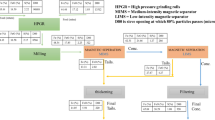Abstract
In the present paper, a new attitude has been proposed for optimization of the separation efficiency (SE) and the Gaudin’s selectivity index (SI) in a flotation process by Hybrid artificial neural network (ANN) and genetic algorithm (GA). The chemical reagent’s dosage (collector, frother and fuel oil), pH, solid percentage, feed rate, Cu, Mo, and Fe grades in the flotation feed were selected as input variables and the SE-Cu and SI-Mo and SI-Fe were selected as output ones. Multilayer NN with back propagation (BP) algorithm was trained by the standard Bayesian regulation algorithm in which the validation data set did not required to be apart from its training. This algorithm with four-layer was used to relate output and input variables. Employment of Hybrid GA–ANN method resulted in significant improvement on GA fitnesses, as SE-Cu = 88, SI-Mo = 4.47 and SI of Fe = 12.85 were achieved. The input parameters corresponding to the fitnesses were as follows: pH = 12.25; the grade of Cu = 0.55%, Mo = 0.04% and Fe = 5.53%; the collector, frother and fuel–oil concentrations being 16.55, 15.54 and 2.71 (g/ton), respectively; the solid percentage was 25.84% and feed rate was 38,380 ton/day. The best fitness of GA was obtained after 10 generations by MSE value of 2.23.












Similar content being viewed by others
References
Lazaridis N K, Matis K A, Stalidis G A, Mavros P, Sep Sci Technol 27 (1992) 1743.
Bulatovic S M, Handbook of Flotation Reagents, Volume 1, Chemistry, Theory and Practice—Flotation of Sulfide Ores, Elsevier, Amsterdam (2007).
Kalyani V K, Pallavika, Chaudhuri S, Mineral Process Extr Metall Rev 29 (2008) 130.
Jorjani E, Asadollahi Poor A H, Sam A, Minerals Eng 22 (2009) 970.
Al-Thyabat S, J China Univ Min Technol 18 (2008) 418.
Kamran Haghighi H, Rafie M, Moradkhani D, Trans Indian Inst Metals 68 (2015) 741.
Kamran Haghighi H, Moradkhani D, Salarirad M M, Trans Indian Inst Metals 67 (2013) 331.
Sivanandam S N, Deepa S N, Introduction to Genetic Algorithm, Springer, Berlin (2008).
Mitra K, Int Mater Rev 53 (2008) 275.
Holland J H, Adaptation in Natural and Artificial Systems, University of Michigan Press, Ann Arbor (1975).
Guria C, Verma M, Gupta S K, Mehrotra S P, Int J Mineral Process 77 (2005) 165.
Ghobadi P, Yahyaei M, Banisi S, Int J Mineral Process 98 (2011) 174.
Chiranjeevi P V, Pandian M R, Sathish T, Bio Resour 9 (2014) 2459.
Changyu S, Lixia W, Qian L, J Mater Process Technol 183 (2007) 412.
Nakhaei F, Mosavi M R, Sam A, Int J Min Sci Technol 23 (2013) 69.
Banisi S, Sarvi M, Hamidi D, Fazeli A, Mineral Process Extr Metall Trans Inst Min Metall C 112 (2003) 198.
Bayar S, Demir I, Engin G O, Ecotoxicol Environ Saf 72 (2009) 843.
Wills B A, Napier Munn T J, Mineral Processing Technology, 7th edition, Elsevier, London (2006).
Gaudin A M, Flotation, 2nd edition, McGraw-Hill, New York (1957).
Turan N G, Mesci B, Ozgonenel O, Chem Eng J 173 (2011) 98.
Youhong Y, Lingen C, Fengrui S, Chih W, Appl Energy 84 (2007) 48.
Benardos P G, Vosniakos G C, Eng Appl Artif Intell 20 (2007) 365.
De S, Kaiadi M, Fast M, Assad M, Energy 32 (2007) 2099.
Hao P, Ling X, Appl Therm Eng 28 (2008) 642.
Karimi F, Rafiee S, Taheri-Garavand A, Karimi M, J Taiwan Inst Chem Eng 43 (2012) 29.
Anderson J, An Introduction to Neural Networks, Prentice-Hall, New Delhi (1995).
Anderson D, McNeill G, Artificial Neural Networks Technology, Data and Analysis Center for Software, New York 258 (1992) 1.
Jameson G J, Flotation cell development The AusIMM Annual Conference, Broken Hill, New South Wales, The Australasian Institute of Mining and Metallurgy, Melbourne (1992) p 25.
Twomey J M, Smith A E, Math Comput Model 21 (1995) 243.
Author information
Authors and Affiliations
Corresponding author
Rights and permissions
About this article
Cite this article
Salmani Nuri, O., Allahkarami, E. & Abdollahzadeh, A. Modeling and Optimization of SE and SI of Copper Flotation via Hybrid GA–ANN. Trans Indian Inst Met 70, 2255–2263 (2017). https://doi.org/10.1007/s12666-017-1078-x
Received:
Accepted:
Published:
Issue Date:
DOI: https://doi.org/10.1007/s12666-017-1078-x




